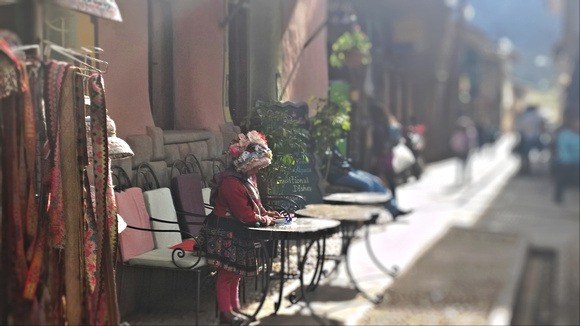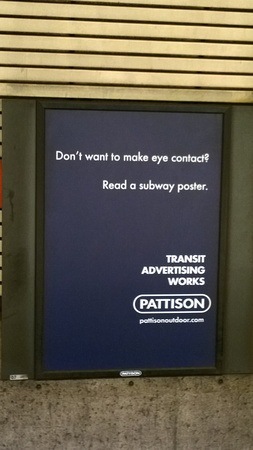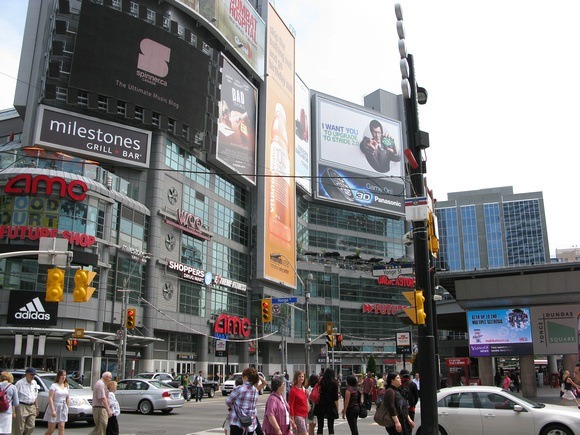“Wow, Nora: you really don’t live here any more, do you?”
This came from a friend who I was visiting whilst recently spending two weeks in my hometown of Toronto. When I tried to pay for our coffee with cash, she looked at me like I was from the moon; she shook her head and handed the cashier a plastic card.
“Is that a Tim Horton’s credit card?” I asked, confused as to why coffee shops would be in the credit card business.
“Um…no, Nora. It’s just a store card. You load it up with credit, and just pay for your coffee quickly and easily with it; no messing with cash.”
As I relayed this revelation to another person, they too, looked at me like I was from the moon. “All kinds of stores have these cards now, Nora.”
Right.
After nine years of living abroad and returning to Canada for periodic visits, I no longer suffer from reverse culture shock or other standard traveler ailments, but apparently I’m stuck in a bit of a time-warp. While living in idyllic (and often rural) little corners of the world, I’ve lost touch with what daily life in Canada (and to a greater extent, North America) is like – for better and worse.
Here are some other differences in daily life between Canada and Peru, as observed during my visit. It’s Peru vs Canada. (I wonder who will win.)

This post was originally published in 2015. It has since been updated for accuracy of links and content.
Plumbing
In Canada, you don’t think twice about flushing toilet paper down the toilet. This is a big no-no in Peru (with the exception of some establishments in major cities like Lima). Peruvian plumbing and water treatment systems just can’t handle toilet paper, so you quickly adapt to the habit of putting toilet paper in a garbage bin.
While in Canada, I actually felt strange about putting my toilet paper in the toilet; a sign that I’d adapted to Peruvian daily life more than I thought.
Water Water Everywhere
Along the lines of plumbing, I was delighted to return to Canada and actually be able to drink the tap water and use it for brushing my teeth. You have to be incredibly careful about tap water in Peru; even rinsing a cup with tap water and reusing it (without drying it thoroughly) is begging for a stomach full of crippling parasites and bacteria. Filtered/treated/bottled water is used for everything – even brushing your teeth. (Here’s how I deal with my water in Peru: Dealing With Parasites – A Guide to Clean Water Around the World).
And since you can drink the tap water in most places in Canada (which some people might argue isn’t potable, but trust me, after experiencing Peruvian water – it is), I was also delighted to see public water fountains. In Peru if I’m out for the day and don’t want to buy a bottle of water (and I detest the plastic waste from bottled water so much so that I’d rather go thirsty), I have to carry around my own bottle of filtered water from home. Not having to do this saved me lots of room in my purse…for buying stuff.
Treatment (and Generation) of Garbage
Speaking of stuff, there’s so much more of it in Canada. And all the stuff you get is packaged ten ways to Sunday, which generates garbage. This garbage from packaging is in addition to the waste generated by the stuff you throw away when buying new stuff to replace old stuff – a seemingly endless cycle that doesn’t exist to nearly the same extent in Peru. My mind boggled at the number of curbside waste bins filled to the brim each and every week.
Despite this little rant about the amount of waste generated in Canada, Peru is not squeaky clean (neither literally nor figuratively) in this example. In (many parts of) Canada, recyclables and organic waste is separated out and treated accordingly. In Peru this isn’t the case, and what’s more, litter is a bit of a problem.
Cash is King vs Plastic Payments
It ires me that cash is king in Peru, since it means I generally suffer ATM withdrawal fees and have frequent flyer mile woes since I can’t charge regular expenses to my credit card and accumulate miles.
Contrast that with my trip to Canada, where I withdrew $100 in cash for good measure….and then redeposited it all back into my account when I left, since I was able to put everything on plastic.
“Do You Have Change?”
I have to ask this question (in Spanish, of course) every time I pull out a crisp 100SOL bill (worth about $30) in Peru – usually the smallest denomination the ATMs will spit out. As with many developing countries, it’s difficult to get change for large bills in Peru (I also experienced this while living in Grenada).
Even if I had used cash in Canada, I wouldn’t have had any trouble getting change.
Smiling at Strangers (or Not)

The picture above was a sad commentary for me on the public state of affairs in Canada (or at least in Toronto). Normally known as a country of friendly outgoing people, I’ve interacted less and less with strangers in Canada as the years have gone by. People are more entranced with looking at their smartphones, e-readers, the ceiling, the floor, these billboards, and everywhere else they can manage, rather than making eye contact and smiling. I know this is a general city-symptom (since I’d like to think that in more rural areas of Canada, small-town friendliness still exists), but it saddens me nonetheless.
In small-town Peru, by contrast, you smile and say hello to just about everybody you pass in the streets.
Do You Deliver?
Living rurally in Peru, there is no such thing as home delivery – of food, mail, or anything else. If I haven’t shopped for groceries, and don’t feel like going out for a meal, I don’t eat.
In Canada, you can order a pizza (or groceries, or sushi, or Ethiopian food) at just about any time. Not only that, but if you’re willing to hit the streets for a meal, in Toronto you can eat just about any world cuisine imaginable. I miss this – and whilst in Toronto, did my best to overdose on favourite ethnic foods.
Disclaimer
Many of the differences of daily life explored in this post aren’t solely applicable to Peru and Canada. In some of the above examples, Peru is a representation for life in many developing countries, as is Canada for life in many Western countries. Also, my life in Peru is largely rural, whereas my time in Canada is urban; another barometer for these differences in daily life.
I was discussing some of these differences with a friend who also lived in Peru and returned to her home town of San Diego. We turned on the camera to have this fun conversation for you!
Click here to view this on YouTube



We went home after a year of travel Nora and couldn’t wait to leave. Stayed for a month, enough time to get some dental/doctor things as well as lots of paperwork done. And visiting our stuff in storage. That was a bit depressing.
But the one thing we did enjoy was ordering in our favorite Indian food. Its what we missed most overseas and you take for granted all the choices you have in Canada.
We stayed a little over a month and were happy to leave. Montreal no longers feel like home and we long ago decided that the day we do come back we’ll settle somewhere else.
Frank (bbqboy)
Hi Frank,
I had similar experiences in my first couple of visits back home. It’s a lot to take in, and the sense that what once was home no longer is, can be a bit of a jolt.
I have a post coming out soon about hometown visits, how to manage them effectively, and the good that can come out of it. Stay tuned!
And I’m with you on the gastronomical factor – I love visiting my fav restaurants whenever I return!
Great Post….But I think not too much difference in both peru and canada…..
Hi Surabhi,
I guess in the grander scheme of things, there aren’t that many differences between most places in the world. In this post, I just noted the quirky differences that I found amusing enough to share.
The TP in the bin is something that I won’t miss about Asia. The subways here in Seoul are finally doing away with the practice. There are signs everywhere, and the TVs on the subway platforms even show ‘lessons’ on the right way for disposal. It’s funny! However, a clean stall with no fear of tracking TP out on your shoes is a huge bonus! These coffee fill-up cards must be recent in the last couple of years. I didn’t seem them in Halifax the last time I was there.
Hey Nancie,
I actually don’t mind putting TP in the bin. I believe countries that do allow TP in the toilet could stand to save a lot of money and resources on waste treatment if we all stopped throwing it in the toilet.
Then again, I haven’t seen bathrooms in Peru that have toilet paper strewn on the floor such that there’s a heightened risk of walking it out with it attached to your shoe. Ha ha! I might have a different take on the situation if that were a common risk. 😉
Funny, but I also live in Toronto, and I don’t use any of these store cards (weren’t even aware there were so many) so don’t feel bad Nora. I usually pay for coffee with cash and everything else with a regular credit card.
I know what you mean about the toiler paper. After visiting many developing countries where you have to throw the paper in the bin, I sometimes unexpectedly have a brain hiccup where I hesitate to throw the paper in the toilet in Canada!
Hey Marie – Glad I’m not the only odd ball…on both the store card and toilet paper issues! 😉
I have been living in Australia for 3.5 years and on my trip back to the
UK I had to use my steripen (to avoid slight stomach aches from the foreign UK water!) and everything seemed so different. The trees were taller, there were more coffee shops, my hometown seemed quite foreign. They skies were always grey and I couldn’t wait to leave.
Hi Sarah,
It’s always interesting revisiting your hometown after being away for a while….in my experience, there are always changes in the landscape that take me by surprise.
I keep reading about the struggles of first-world-ers and water, and I’m always amused. Not in a mean way, but in a my-stomach-must-be-full-of-bugs way. I’ve traveled, and not once water gave me problems. Drank from tap, bottles, fountains… Nothing.
Even more: Last week the tap water and treatment plant water accidentally mixed, so the dishes we use to eat at the office’s diner were literally washed with poop water.
Over 300 persons at the office were sick for several days. Me? Nothing.
Mexican unhealthy food + traveling shielded my insides.
TP on the bin always bothered me. Modern TP almost disappears when in contact with water, and I have a real hard time thinking the sewer system can’t handle it.
Before, people used crumpled newspaper, so I understand the need to dump it in the bin back then. But modern TP shouldn’t be an issue, even on old sewer infrastructure.
Yet, a niece once managed to block the drain on an apartment. How she did it, it’s beyond me. I think she probably mummified her hand with TP to wipe, or dumped a whole roll down the drain.
Happy to hear from you again Nora!
Hey Jorge,
Ha ha ha – mummified her hand with TP!!! Yes, some people do actually do that. 😉
I always thought I had an iron stomach (like you), but alas, I’ve had a few rough bouts with parasites such that I’m much more careful about water (and even street food) than I once was. Which is a shame because I Loooooooove street food….
Oh how I can relate! Expat life in this part of Asia sounds very similar: Toilet paper in the bin.. non-potable water… cash withdrawals or watching currency fluctuations to optimally time a money-exchange. Never mind the visa quagmire and medical checkup quandaries (Thailand, Singapore or… Canada?). Thanks so much for sharing your experiences; it makes me appreciate the Canadian kinship factor even more, during my lengthy stay(s) in Bali, so far from ‘home’…
Hi Amit,
Indeed, I remember many of these similarities from my (short-ish) time in Asia. And I hear you on the visa and medical angles…although admittedly, I’ve found medical care in other countries around the world to be very effective, and often a fraction of the cost of Canada (given that I don’t qualify for Canadian healthcare any longer)…
https://www.theprofessionalhobo.com/the-best-and-cheapest-doctor-i-ever-visited-was-in-the-usa/
I was looking for something on Google and this post came up. For anyone else that comes across this …. as someone who has been to many places in North and South America I think this is not a fair comparison. comparing Toronto one of North America’s largest cities to rural Peru. It’s not the right comparison at all and to the author it’s unfortunate that you were not able to visit rural Canada which has some more similarities to rural Peru than you would imagine. Toronto to Lima would have been the right comparison. Toronto, New York City, Los Angeles and Mexico City those are fair comparisons being the largest cities in North America to Sao Paulo, Buenos Aires, Rio de Janeiro, Lima and Bogota in South America.
Hi David,
Thank you for this comment, and you make a fair point!